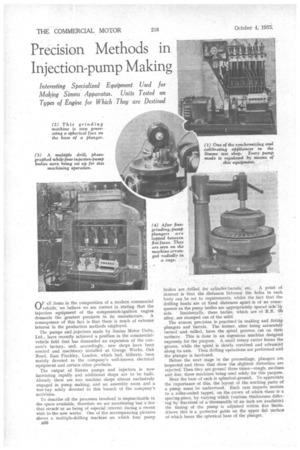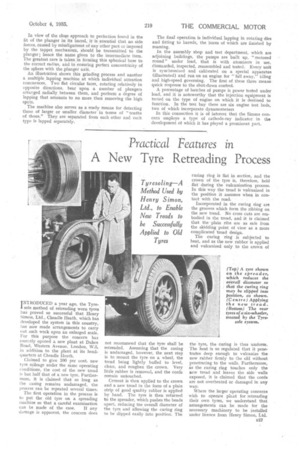Precision Methods in Injection-pump Making
Page 40

Page 41

If you've noticed an error in this article please click here to report it so we can fix it.
OF all items in the composition of a modern commercial vehicle, we believe we are Correct in Stating that the injection equipment of the compression-ignition engine demands the greatest precision in its manufacture. A consequence of this fact is that there is much of extreme interest in the production methods employed.
The pumps and ;injectors made by Simms Motor Units, Ltd., have recently achieved a position in the commercialvehicle field that has demanded an expansion of the concern's factory, and, accordingly, new shops have been erected and machinery installed at Grange Works, Oak Road, East Finchley, London, which had, hitherto, been mainly devoted to the company's well-known electrical equipment and certain other products.
The output of Simms pumps and injectors is now increasing rapidly and additional shops are to be built. Already there are two machine shops almost exclusively engaged in pump making, and an assembly room and a test-bay solely devoted to this branch of the company's activities.
To describe all the processes involved is impracticable in the space available, therefore we are mentioning but a few that struck, us as being of especial interest during a recent visit to the new works. One of the accompanying pictures shows a multiple-drilling machine on which four pump
D26 bodies are. drilled for cylinder-barrels, etc. A point of interest is that the distances between the holes in each body can be set to requirements, whilst the _fact that the drilling heads are at fixed distances apart is of no consequence as the pump bodies are appropriately spaced side by side. Incidentally, these bodies, which are of R.R. ii alloy, are stamped out of the solid.
The utmost precision is practised in making and fitting plungers and barrels. The former, after being accurately • turned and. milled, have the spiral grooves cut on their surfaces. This is done in an ingenious machine designed expressly for the purpose. A small rotary cutter forms the groove, while the spiral is slowly revolved and arlyaticed along its axis. Then drilling operations are performed•and the plunger is hardened.
Before the next stage in the proceedings, plungers are inspected and those that show the slightest distortion are rejected. Then they are ground three times—rough, medium and fine, three machines being used solely for this purpose.
Next the base of each is spherical-ground. To appreciate the importance of this, the layout of the working parts of a pump must be understood. Each cam imparts motion to a roller-ended tappet, on the crown of which there is• a spacing-piece, by varying which (various thieknestes. differing by fractions' of a thousandth of an inch are available) the timing of the pump is adjusted within fine limits. Above this is a protector guide on the upper flat surface of which bears the spherical base of the plunger.
In view of the close approach to perfection found in the fit of the plunger in its barrel, it is essential that no side• forces, caused by misalignment of any other part or imposed by the tappet mechanism, should be transmitted to the plunger; hence the name given to the intermediate item. The greatest care is taken in forming this spherical base to the correct radius, and in ensuring perfect concentricity of
the sphere with the ,plunger axis.
An illustration shows this grinding process and another a multiple lapping machine at which individual attention commences. Two flat circular faces, rotating relatively in opposite directions, bear upon a number of plungers arranged radially between them, and perform a degree of lapping that amounts to no more than removing the high spots.
The machine also serves as a ready means for detecting those of larger or smaller, diameter in terms of "tenths of thous." They are separated from each other and each type is lapped separately. The final operation is individual lapping in rotating dies and• fitting to barrels, the bores of which are finished by reaming.
In the assembly shop and test department, which are adjoining buildings, the pumps are built up, "motored round" under load, that is with atomizers in use, dismantled, inspected, reassembled and tested. Every unit is synchronized and calibrated on a special apparatus (illustrated) and run on an engine for "fall away," idling and high-speed governing. The first of these three meansquick response to the shut-down control.
A percentage of batches of pumps is power tested under load, and it is noteworthy that the injection equipment is tested on the type of engine on which it is. destined to function. In the test bay there are six engine test beds, two of which incorporate dynamometers In this connection it is of interest that the Simms concern employs a type of cathode-ray indicator in the development of which it has played a prominent part.




























































































